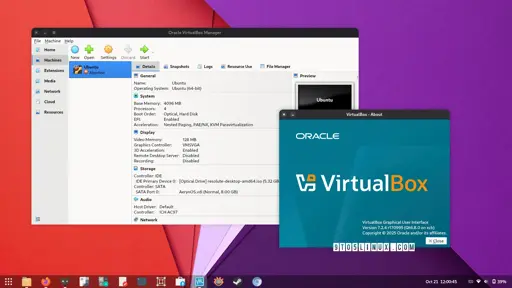virtmanager and boxes for qemu/kvm have freed me from the accursed Oracle product and it’s dkms modules
I still use VirtualBox but a version built to work with KVM.
https://github.com/cyberus-technology/virtualbox-kvm
It does not need a kernel module or DKMS because it uses KVM.
Oracle is accused though.
Interesting! What are its upsides over virt-manager?
I keep forgetting that Virtual Box exists because Hyper-V has been available since Win7 and nix has qemu or KVM for native virtualisation.
I still use Virtualbox, configuration is way easier with the GUI and defaults don’t pass any USB devices.
I still use Virtualbox, configuration is way easier with the GUI
To be fair you can pair KVM/qemu with any GUI manager and have a similar interface to VirtualBox/Hyper-V/VMWare/etc. virt-manager (https://virt-manager.org/) is a popular one for example, I just started using it and it seems to work well for what I need.
Normally I’ve been using VirtualBox but for whatever reason it asks me to recompile the kernel on Debian 13 just to launch. Meanwhile qemu just works.
You can use VirtualBox with KVM as well.
https://github.com/cyberus-technology/virtualbox-kvm
You are probably not recompiling the kernel but rather just a kernel module (DKMS). Still annoying.
You do not need a kernel module for the version above as it KVM is already in the kernel. That is why QEMU does not need a kernel module either.
Yup. Virtualbox has some really sane defaults. It is very easy to use.
VirtualBox also has snapshots, which is useful when the VM is used to “play around the OS” and possibly break the OS, such as sandboxing a custom OS build, checking out a malware, etc
KVM/Qemu and Hyper-V also have snapshots, but hyper-v has a dumb name for them that I always forget.
Remember : using virtualbox at work is not free
And… you need the correct licenses for any Windows VMs.
So those Windows 2025 servers running on your laptop needs a license too… or use Linux…
I used VirtualBox on Linux to host my Home Assistant server for a while. I kept having odd issues with usb devices. I’d have to disconnect and reconnect them to get them working again.
Many people in the HA help groups say not to use VirtualBox, and at first I thought they were basing that on old info. But then I started having issues, too. On the other hand, kvm has been rock solid for a long time.
So I’m glad to see they continue to develop it, but I wouldn’t recommend it for heavy duty use. It’s useful to dipping toes into virtualization, or maybe for running systems for the short term (a few hours here and there, or something), but for long term use, I’d go another route. It’s certainly easier to set up the network in VirtualBox, I’ll grant that - it took me a while to get it right for HA on kvm. (Of course, that’s a one-time setup thing, too - I shouldn’t have to touch it again. And don’t ask me what I did, because I don’t remember!)
I’ve been too lazy to rebuild my windows work VM in something different and never really had any issues with VirtualBox. I know there are better solutions out there I just can’t be stuffed.






